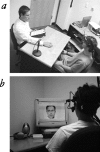Amygdala damage impairs eye contact during conversations with real people
- PMID: 17428974
- PMCID: PMC6672539
- DOI: 10.1523/JNEUROSCI.3789-06.2007
Amygdala damage impairs eye contact during conversations with real people
Abstract
The role of the human amygdala in real social interactions remains essentially unknown, although studies in nonhuman primates and studies using photographs and video in humans have shown it to be critical for emotional processing and suggest its importance for social cognition. We show here that complete amygdala lesions result in a severe reduction in direct eye contact during conversations with real people, together with an abnormal increase in gaze to the mouth. These novel findings from real social interactions are consistent with an hypothesized role for the amygdala in autism and the approach taken here opens up new directions for quantifying social behavior in humans.
Figures


References
-
- Adolphs R, Spezio ML. Role of the amygdala in processing visual social stimuli. Prog Brain Res. 2006;156:363–378. - PubMed
-
- Adolphs R, Tranel D. Emotion recognition and the human amygdala. In: Aggleton JP, editor. The amygdala. A functional analysis. New York: Oxford UP; 2000. pp. 587–630.
-
- Adolphs R, Tranel D, Damasio AR. The human amygdala in social judgment. Nature. 1998;393:470–474. - PubMed
-
- Adolphs R, Tranel D, Hamann S, Young A, Calder A, Anderson A, Phelps E, Lee GP, Damasio AR. Recognition of facial emotion in nine subjects with bilateral amygdala damage. Neuropsychologia. 1999;37:1111–1117. - PubMed
-
- Adolphs R, Gosselin F, Buchanan TW, Tranel D, Schyns P, Damasio AR. A mechanism for impaired fear recognition after amygdala damage. Nature. 2005;433:68–72. - PubMed
Publication types
MeSH terms
Grants and funding
LinkOut - more resources
Full Text Sources
